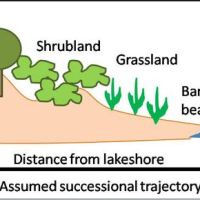Introducing Exotic Dung Beetles to New Zealand
Posted: May 2, 2017 Filed under: 2017, ERES525, Research Essay Leave a commentBy Laura Malin-Curry
I remember driving through the country 10 years ago complaining to my grandfather how boring farms were to look at. My grandfather then replied that “that boring farm consists a dynamic relationship, where the sun provides the grass energy to grow, which then feeds the cows that in turn feed us”. Farms are novel ecosystems, built to sustain human development and growth. Globally, agriculture covers around 40% of terrestrial land area1. Locally, agriculture accounts for two-thirds of New Zealand’s exports, valued over $14.8 billion2.
As New Zealand’s economy is largely built around agriculture, maintaining and improving agricultural productivity is a primary goal for most farmers3. Currently, New Zealand native, forest dwelling, dung beetles are maladaptive to deal with pastoral dung. Resulting in dung limiting the amount of pastoral land available for grazing, thus adversely affecting the productivity of a farm3. To mitigate pastoral dung the Dung Beetle Release strategy Group aim to release 11 additional species of dung beetles into New Zealand to enhance the sustainable production of farms3.
The introduction of dung beetles into New Zealand pasture ecosystems has been in consideration for over 40 years8. However, movement took off in 2008 after the establishment of the Dung Beetle Release Strategy Group by a group of farmers and interested investors3. For the Dung Beetle Release Strategy Group to receive permission and funding to release exotic dung beetles, they had to provide information that 1- the dung beetles will not pose a threat to New Zealand native ecosystems and 2- that introducing dung beetles will be economically viable9.
Approximately $600,000 was invested into ensuring the safety of New Zealand ecosystem health upon releasing dung beetles3. And in 2011 the Environmental Protection Authority approved the release for 11 species9. In February 2014 the Dung Beetle Release Strategy Group completed a total of 74 dung beetle releases over 7 regions3. It is still too early to understand the impact that introduced dung beetles have on New Zealand’s agriculture.
Numerous countries are already benefiting from introducing dung beetles onto their pastoral land, such as Australia, America and Brazil3. These successful introductions give New Zealand a good indication towards the benefits that dung beetles will have on New Zealand. These benefits include; increasing farms productivity3, less greenhouse gas emissions7, reduction of livestock being infested with parasitic worms6 and the clearing up of New Zealand waterways9.
Releasing dung beetles into New Zealand to compliment, and enhance a novel ecosystem is not directly considered restoration. However, non-direct effects of dung beetles, like clearing up our waterways9, can be. The release will also positively affect our understandings in introducing species outside of their natural range. Adding to the tool box of conservation, resulting in better informed decision makings around the purposeful movement of a species outside of their native range.
Even though farms are artificial ecosystem composed of exotic species, I believe it is in New Zealand’s best environmental9 and economic interest2 to release exotic dung beetles to mitigate the effect of pastoral dung. Dung beetles are the missing link in our agricultural ecosystem, complimenting exotic stock life. Benefits of dung beetle release have already been seen in other countries3. Dung beetle release is well researched and will positively affect our agriculture. Soon enough we will see these exotic dung beetles as an ingrained vital component to our agricultural ecosystems.
References
- FAO stat, 2010, FAO stat, http://faostat.fao.org/site/339/default.aspx(2010) (Accessed March 2017)
- Sarah Brazil, ed. (2008).New Zealand Official Yearbook. Statistics New Zealand. p. 357. ISBN 978-1-86953-717-3. The export figure includes agriculture, horticulture and forestry.
- Dung Beetle Release Strategory Group. (2017, March 20). Dung Beetles in New Zealand. Retrieved from Dung Beetle: http://dungbeetle.org.nz/orders/
- Department of Conservation. (2017, March 25). Predator Free New Zealand 2050 to be a massive team effort. Retrieved from the Department of Conservation: http://www.doc.govt.nz/news/media-releases/2016/predator-free-nz-2050-to-be-a-massive-team-effort/
- King, C. (1984).Immigrant killers: Introduced predators and the conservation of birds in New Zealand / Carolyn King. Auckland, N.Z.: Oxford University Press.
- Nichols, Spector, Louzada, Larsen, Amezquita, & Favila. (2008). Ecological functions and ecosystem services provided by Scarabaeinae dung beetles.Biological Conservation, 141(6), 1461-1474.
- Slade, Eleanor M., Riutta, Terhi, Roslin, Tomas, & Tuomisto, Hanna L. (2016). The Role of Dung Beetles in Reducing Greenhouse Gas Emissions From Cattle Farming.Scientific Reports, 6, Scientific Reports, 2016, Vol.6.
- Hughes, R. (1975). Introduced Dung Beetles and Australian Pasture Ecosystems. Papers Presented At A Symposium During The Meeting Of The Australia and New Zealand Association For The Advancement Of Science At Canberra In January 1975.The Journal of Applied Ecology, 12(3), 819-837.
- Environmental Protection Authority. (2017, May 1). The Dung Beetle Decision. Retrieved from Environmental Protection Authority: http://www.epa.govt.nz/new-organisms/popular-no-topics/dungbeetles/Pages/decision.aspx




